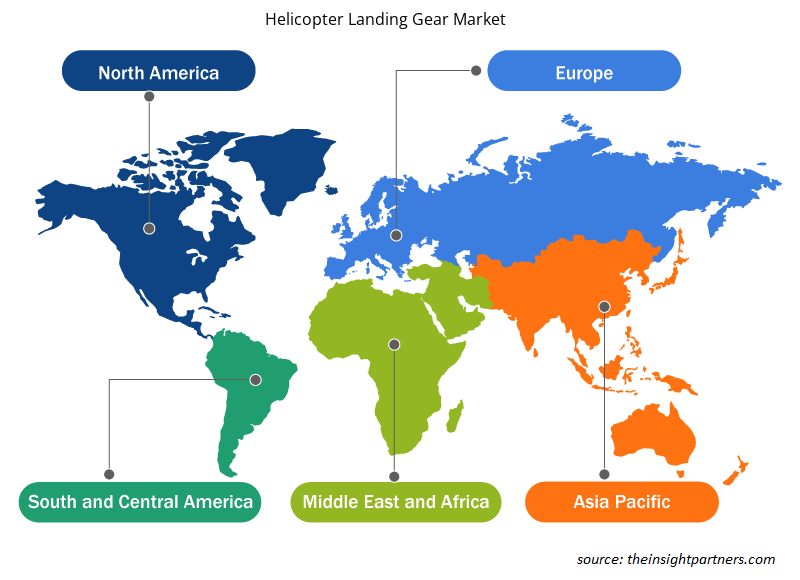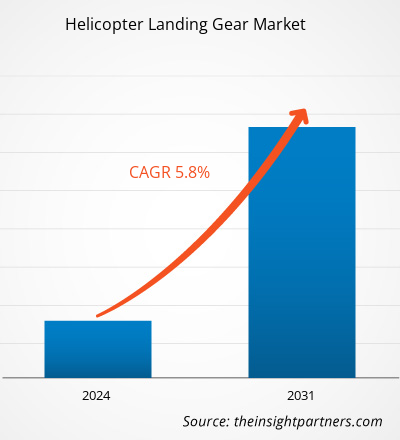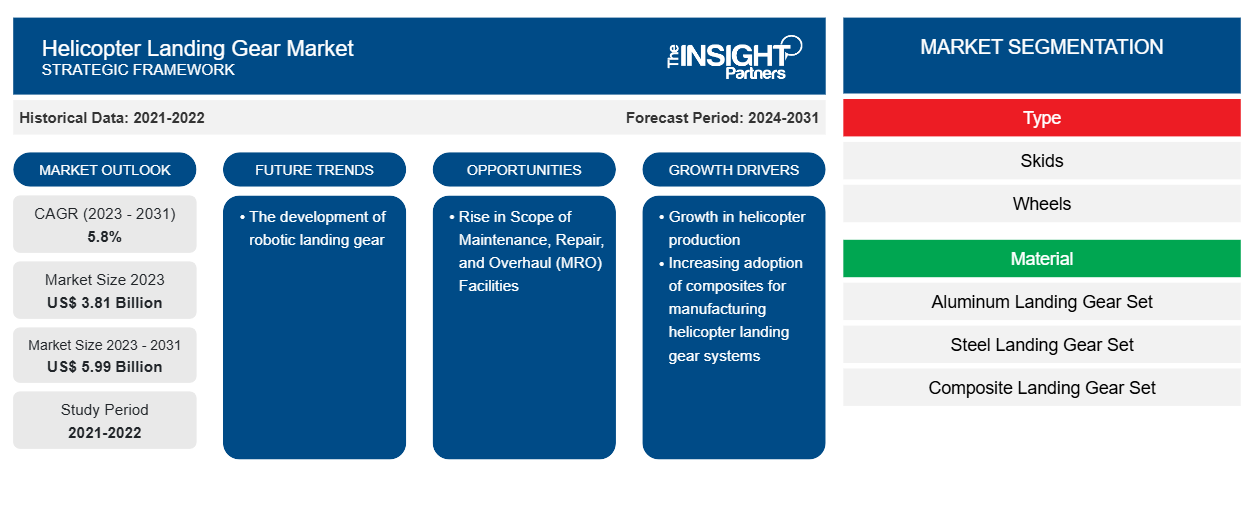Le marché des trains d'atterrissage pour hélicoptères devrait atteindre 5,99 milliards de dollars d'ici 2031, contre 3,81 milliards de dollars en 2023. Le marché devrait enregistrer un TCAC de 5,8 % au cours de la période 2023-2031. Le développement de trains d'atterrissage robotisés devrait rester une tendance clé du marché.
Analyse du marché des trains d'atterrissage pour hélicoptères
L'industrie mondiale de fabrication ou de modernisation d'hélicoptères est caractérisée par la présence de fabricants d'hélicoptères bien connus et financièrement solides tels qu'Airbus et Bell Helicopter. De ce fait, le pouvoir de négociation des acheteurs sur le marché des trains d'atterrissage d'hélicoptères est assez élevé à l'heure actuelle, mais il devrait diminuer à un niveau modéré dans les années à venir. Les fabricants d'hélicoptères tels qu'Airbus, Bell Helicopters, Sikorsky Aircraft Corporation, entre autres, ont une rivalité concurrentielle féroce entre eux et ils ont besoin d'améliorer constamment leurs appareils pour maintenir leur position dominante sur le marché. De ce fait, ces entreprises ont une forte tendance à changer de sous-traitant de composants d'hélicoptères au fil du temps, afin d'améliorer l'ensemble des systèmes d'hélicoptères. Par conséquent, en raison de la nature consolidée de l'industrie de fabrication d'hélicoptères avec la présence de quelques grands fabricants d'hélicoptères, le pouvoir de négociation des acheteurs devrait rester élevé dans les années à venir.
Aperçu du marché des trains d'atterrissage pour hélicoptères
Le marché des trains d'atterrissage pour hélicoptères est composé d'un grand nombre d'entreprises bien établies et reconnues telles que Safran SA, Liebherr Group, Héroux-Devtek Inc., Circor International, Inc. et Triumph Group Inc., entre autres. Ces acteurs du marché ont une position de marque bien établie et une présence à long terme sur le marché mondial des trains d'atterrissage. Les fabricants d'hélicoptères dépendent fortement de la valeur de la marque des fabricants de composants d'hélicoptères et, de ce fait, la majorité des contrats sont attribués aux fabricants de trains d'atterrissage pour hélicoptères établis et reconnus par l'industrie, créant ainsi un espace minimum pour que les nouveaux fabricants puissent entrer sur le marché. En outre, les investissements initiaux en capital nécessaires pour entrer sur le marché des trains d'atterrissage pour hélicoptères sont assez élevés, ce qui constitue une barrière à l'entrée pour les nouveaux entrants.
Personnalisez ce rapport en fonction de vos besoins
Vous bénéficierez d'une personnalisation gratuite de n'importe quel rapport, y compris de certaines parties de ce rapport, d'une analyse au niveau des pays, d'un pack de données Excel, ainsi que de superbes offres et réductions pour les start-ups et les universités.
-
Obtenez les principales tendances clés du marché de ce rapport.Cet échantillon GRATUIT comprendra une analyse de données, allant des tendances du marché aux estimations et prévisions.
Moteurs et opportunités du marché des trains d'atterrissage pour hélicoptères
La production mondiale d'hélicoptères augmente
L'augmentation du nombre de productions et de livraisons d'hélicoptères dans le monde est l'un des principaux facteurs favorisant l'adoption de trains d'atterrissage pour hélicoptères civils et militaires dans différentes régions du monde. Par exemple, selon la General Aviation Manufacturers Association (GAMA), environ 1072 hélicoptères civils ont été livrés en 2022, contre 1007 hélicoptères en 2021. En outre, selon la GAMA, les livraisons d'hélicoptères à pistons ont connu une croissance d'environ 7,7 % en 2023, avec 209 unités livrées dans le monde ; tandis que les hélicoptères à turbine civils et commerciaux ont connu une augmentation d'environ 9,9 % avec 811 unités en 2023. Cette croissance des livraisons et de la production d'hélicoptères stimule la croissance du marché des trains d'atterrissage pour hélicoptères dans le monde entier.
Augmentation de la portée des installations de maintenance, de réparation et de révision (MRO)
La croissance exponentielle des hélicoptères a complété la création d'installations MRO dans le monde au fil des ans. La portée des installations MRO devrait augmenter dans différentes parties du monde, en particulier en Asie. En raison de l'adoption croissante des hélicoptères civils à diverses fins commerciales telles que la lutte contre les incendies de forêt, la facilitation de la couverture de l'actualité et du trafic, la conduite de missions de recherche et de sauvetage et la patrouille des gazoducs et oléoducs, la création d'installations MRO connaît également une tendance positive. L'utilisation croissante des hélicoptères accélère rapidement la portée de l'activité de maintenance des hélicoptères. Des pays comme Singapour et l'Inde constatent la présence d'entreprises proposant des services MRO associés aux trains d'atterrissage d'hélicoptères. Tentacle Aerologistix Pvt. Ltd. s'est lancée dans le domaine de la MRO dans le but de créer une référence dans la maintenance des aéronefs. En outre, plusieurs pays émergents ont également annoncé leur intention d'établir un pôle MRO dans leurs régions respectives. Par exemple, le gouvernement indien a annoncé qu'il ferait du pays un pôle MRO aéronautique, ce qui devrait encore stimuler la demande de systèmes de trains d'atterrissage d'hélicoptères dans la région.
Analyse de segmentation du rapport sur le marché des trains d'atterrissage pour hélicoptères
Les segments clés qui ont contribué à l’élaboration de l’analyse du marché des trains d’atterrissage pour hélicoptères sont le type, le matériau et l’application.
- En fonction du type, le marché des trains d'atterrissage pour hélicoptères est divisé en patins et roues. Le segment des patins détenait une part de marché plus importante en 2023.
- En fonction du matériau, le marché des trains d'atterrissage pour hélicoptères est segmenté en trains d'atterrissage en aluminium, trains d'atterrissage en acier, trains d'atterrissage composites et trains d'atterrissage en titane . Le segment composite détenait une part de marché plus importante en 2023.
- En fonction des applications, le marché des trains d'atterrissage pour hélicoptères est divisé en hélicoptères civils et hélicoptères militaires. Le segment des hélicoptères militaires détenait une part de marché plus importante en 2023.
Analyse des parts de marché des trains d'atterrissage pour hélicoptères par zone géographique
La portée géographique du rapport sur le marché des trains d’atterrissage pour hélicoptères est principalement divisée en cinq régions : Amérique du Nord, Europe, Asie-Pacifique, Moyen-Orient et Afrique et Amérique du Sud.
L'Amérique du Nord a dominé le marché en 2023, suivie de l'Europe et de la région Asie-Pacifique. En outre, l'Asie-Pacifique devrait également connaître le TCAC le plus élevé dans les années à venir. Les États-Unis ont dominé le marché des trains d'atterrissage pour hélicoptères en Amérique du Nord en 2023. L'US Air Force est l'une des forces armées les plus puissantes et les plus avancées technologiquement au monde. Le gouvernement américain investit constamment dans le développement d'une base industrielle de défense dans le pays, en raison d'une attention particulière portée à l'expansion des capacités militaires en tant que priorité stratégique. En 2023, les dépenses militaires des États-Unis se sont élevées à 916 milliards de dollars américains, soit une augmentation de 4,4 % par rapport à l'année précédente. Les États-Unis devraient être le plus grand contributeur de revenus sur le marché mondial des trains d'atterrissage pour hélicoptères en raison des dépenses continues en R&D pour renforcer le secteur militaire, ainsi que de la présence de certains des principaux fabricants d'hélicoptères de combat et de trains d'atterrissage. CIRCOR Aerospace et Safran font partie des principaux fabricants opérant sur le marché américain des trains d'atterrissage. Par conséquent, le marché des trains d'atterrissage pour hélicoptères devrait croître tout au long de la période projetée en raison des facteurs mentionnés ci-dessus.
Portée du rapport sur le marché des trains d'atterrissage pour hélicoptères
Aperçu régional du marché des trains d'atterrissage pour hélicoptères
Les tendances et facteurs régionaux influençant le marché des trains d’atterrissage pour hélicoptères tout au long de la période de prévision ont été expliqués en détail par les analystes d’Insight Partners. Cette section traite également des segments et de la géographie du marché des trains d’atterrissage pour hélicoptères en Amérique du Nord, en Europe, en Asie-Pacifique, au Moyen-Orient et en Afrique, ainsi qu’en Amérique du Sud et en Amérique centrale.

- Obtenez les données régionales spécifiques au marché des trains d'atterrissage pour hélicoptères
Portée du rapport sur le marché des trains d'atterrissage pour hélicoptères
| Attribut de rapport | Détails |
|---|---|
| Taille du marché en 2023 | 3,81 milliards de dollars américains |
| Taille du marché d'ici 2031 | 5,99 milliards de dollars américains |
| Taux de croissance annuel composé mondial (2023-2031) | 5,8% |
| Données historiques | 2021-2022 |
| Période de prévision | 2024-2031 |
| Segments couverts |
Par type
|
| Régions et pays couverts |
Amérique du Nord
|
| Leaders du marché et profils d'entreprises clés |
|
Densité des acteurs du marché des trains d'atterrissage pour hélicoptères : comprendre son impact sur la dynamique commerciale
Le marché des trains d'atterrissage pour hélicoptères connaît une croissance rapide, tirée par la demande croissante des utilisateurs finaux en raison de facteurs tels que l'évolution des préférences des consommateurs, les avancées technologiques et une plus grande sensibilisation aux avantages du produit. À mesure que la demande augmente, les entreprises élargissent leurs offres, innovent pour répondre aux besoins des consommateurs et capitalisent sur les tendances émergentes, ce qui alimente davantage la croissance du marché.
La densité des acteurs du marché fait référence à la répartition des entreprises ou des sociétés opérant sur un marché ou un secteur particulier. Elle indique le nombre de concurrents (acteurs du marché) présents sur un marché donné par rapport à sa taille ou à sa valeur marchande totale.
Les principales entreprises opérant sur le marché des trains d'atterrissage pour hélicoptères sont :
- Circor Aérospatiale Inc.
- Sika Interplant Systems Limited
- DART AÉROSPATIALE
- Eurocarbon BV
- Trelleborg
- Rostec
Avis de non-responsabilité : les sociétés répertoriées ci-dessus ne sont pas classées dans un ordre particulier.

- Obtenez un aperçu des principaux acteurs du marché des trains d'atterrissage pour hélicoptères
Actualités et développements récents du marché des trains d'atterrissage pour hélicoptères
Le marché des trains d'atterrissage pour hélicoptères est évalué en collectant des données qualitatives et quantitatives après des recherches primaires et secondaires, qui comprennent d'importantes publications d'entreprise, des données d'association et des bases de données. Quelques-uns des développements sur le marché des trains d'atterrissage pour hélicoptères sont énumérés ci-dessous :
- Safran Landing Systems participe au programme d'avions à rotors basculants de Bell, dans le cadre du projet FLRAA (Future Long-Range Assault Aircraft) de l'armée américaine. Selon le contrat, Safran Landing Systems concevra et développera le système d'atterrissage entièrement intégré. Ces efforts communs établiront des bases solides pour répondre à toutes les exigences futures. (Source : Safran, Communiqué de presse, septembre 2023)
- Trelleborg Sealing Solutions lance son matériau composite Orkot® C620, spécialement développé pour répondre aux besoins de l'industrie aéronautique, notamment à l'exigence d'un matériau résistant et léger pour résister aux charges et contraintes élevées auxquelles sont soumis les trains d'atterrissage. (Source : Trelleborg Sealing Solutions, Communiqué de presse, février 2022)
Rapport sur le marché des trains d'atterrissage pour hélicoptères : couverture et livrables
Le rapport « Taille et prévisions du marché des trains d’atterrissage pour hélicoptères (2021-2031) » fournit une analyse détaillée du marché couvrant les domaines ci-dessous :
- Taille et prévisions du marché des trains d'atterrissage pour hélicoptères aux niveaux mondial, régional et national pour tous les segments de marché clés couverts par le champ d'application
- Tendances du marché des trains d'atterrissage pour hélicoptères ainsi que la dynamique du marché telles que les facteurs déterminants, les contraintes et les opportunités clés
- Analyse détaillée des cinq forces du porteur
- Analyse du marché des trains d'atterrissage pour hélicoptères couvrant les principales tendances du marché, le cadre mondial et régional, les principaux acteurs, les réglementations et les développements récents du marché
- Analyse du paysage industriel et de la concurrence couvrant la concentration du marché, l'analyse de la carte thermique, les principaux acteurs et les développements récents pour le marché des trains d'atterrissage pour hélicoptères
- Profils d'entreprise détaillés
- Analyse historique (2 ans), année de base, prévision (7 ans) avec TCAC
- Analyse PEST et SWOT
- Taille du marché Valeur / Volume - Mondial, Régional, Pays
- Industrie et paysage concurrentiel
- Ensemble de données Excel
Rapports récents
Témoignages
Raison d'acheter
- Prise de décision éclairée
- Compréhension de la dynamique du marché
- Analyse concurrentielle
- Connaissances clients
- Prévisions de marché
- Atténuation des risques
- Planification stratégique
- Justification des investissements
- Identification des marchés émergents
- Amélioration des stratégies marketing
- Amélioration de l'efficacité opérationnelle
- Alignement sur les tendances réglementaires























 Obtenez un échantillon gratuit pour - Marché des trains d'atterrissage pour hélicoptères
Obtenez un échantillon gratuit pour - Marché des trains d'atterrissage pour hélicoptères